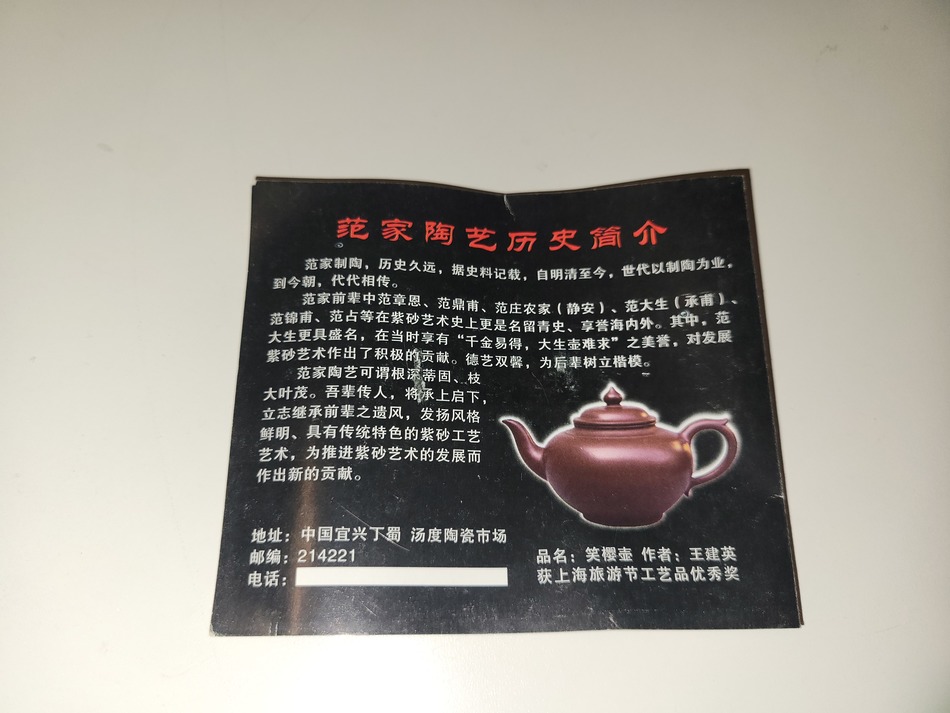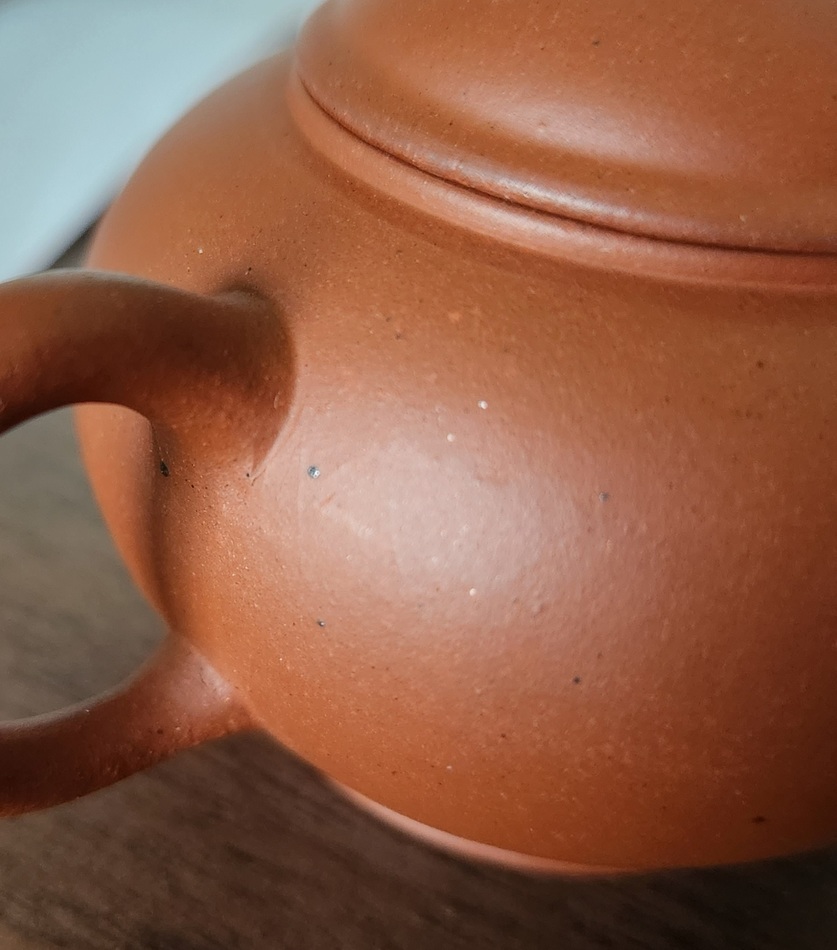This colour I have come across on fully coated Yixing, Neiwailinjiang or very high fired Zhuni. But these were all vintage or older pots, so maybe does not apply here.
Yixing
I think you are on the right track. Imo it is due to lack of oxygen in the interior during firing leading to reduction. This is then exposed in some areas after grinding for lid fit.
Huh...hahaha this might actually be more complicated than i imagined!
I just examined the lid seat again, seems more like reduction-fired spots, doesn't seem to have a coated layer
I'm not really sure though haha, probably some blend? I guess i'll never know!
Also, the seller stated he got it in Osaka 15 years ago
Thank you guys! Sincerely appreciate all of your help! Have a pleasant week!
Have a pleasant week!
I just examined the lid seat again, seems more like reduction-fired spots, doesn't seem to have a coated layer
I'm not really sure though haha, probably some blend? I guess i'll never know!
Also, the seller stated he got it in Osaka 15 years ago
Thank you guys! Sincerely appreciate all of your help!
You are welcome! I don't think the different color is due to blending, just reduction. But that pot is likely a blend, judging by the color I would guess that iron oxide was added.haxxor wrote: ↑Thu Jun 15, 2023 9:32 amHuh...hahaha this might actually be more complicated than i imagined!
I just examined the lid seat again, seems more like reduction-fired spots, doesn't seem to have a coated layer
I'm not really sure though haha, probably some blend? I guess i'll never know!
Also, the seller stated he got it in Osaka 15 years ago
Thank you guys! Sincerely appreciate all of your help!Have a pleasant week!
steanze wrote: ↑Thu Jun 15, 2023 11:01 amYou are welcome! I don't think the different color is due to blending, just reduction. But that pot is likely a blend, judging by the color I would guess that iron oxide was added.haxxor wrote: ↑Thu Jun 15, 2023 9:32 amHuh...hahaha this might actually be more complicated than i imagined!
I just examined the lid seat again, seems more like reduction-fired spots, doesn't seem to have a coated layer
I'm not really sure though haha, probably some blend? I guess i'll never know!
Also, the seller stated he got it in Osaka 15 years ago
Thank you guys! Sincerely appreciate all of your help!Have a pleasant week!
-
teacreacha7
- Posts: 40
- Joined: Mon Jun 19, 2023 5:23 am
- Location: Colorado
Hey folks,
I've been lurking for a bit, but I just got my first yixing on a whim. I would love to hear what you think about it! So far the tea it makes tastes good, and I enjoy using it. It comes with a certificate of authenticity, which I don't really put much stock in. Did I make a horrible mistake? (It was an adventure buying it, and I don't feel I overpayed, so I have no regrets!)
- Size of pot: 135 ml
- Clay type: claims to be Dahongpao, but I am highly skeptical of this.
- Firing tempurature: Unknown.
- thickness: medium, but I have no point of comparison.
- pour: 12-13 seconds
- year made: Modern, exact year unknown.
- craftsman: Wang Jianying, Fan family pottery.
- type of tea: Sheng pu'er
- effect on tea: too early to tell.
I've been lurking for a bit, but I just got my first yixing on a whim. I would love to hear what you think about it! So far the tea it makes tastes good, and I enjoy using it. It comes with a certificate of authenticity, which I don't really put much stock in. Did I make a horrible mistake? (It was an adventure buying it, and I don't feel I overpayed, so I have no regrets!)
- Size of pot: 135 ml
- Clay type: claims to be Dahongpao, but I am highly skeptical of this.
- Firing tempurature: Unknown.
- thickness: medium, but I have no point of comparison.
- pour: 12-13 seconds
- year made: Modern, exact year unknown.
- craftsman: Wang Jianying, Fan family pottery.
- type of tea: Sheng pu'er
- effect on tea: too early to tell.
@teacreacha7teacreacha7 wrote: ↑Mon Jun 19, 2023 8:39 amHey folks,
I've been lurking for a bit, but I just got my first yixing on a whim. I would love to hear what you think about it! So far the tea it makes tastes good, and I enjoy using it. It comes with a certificate of authenticity, which I don't really put much stock in. Did I make a horrible mistake? (It was an adventure buying it, and I don't feel I overpayed, so I have no regrets!)
- Size of pot: 135 ml
- Clay type: claims to be Dahongpao, but I am highly skeptical of this.
- Firing tempurature: Unknown.
- thickness: medium, but I have no point of comparison.
- pour: 12-13 seconds
- year made: Modern, exact year unknown.
- craftsman: Wang Jianying, Fan family pottery.
- type of tea: Sheng pu'er
- effect on tea: too early to tell.

It seems to be modern hongni. If the certificate date (辛卯年) is correct, it’s made in 2011. Artisan has no official title. The most important part is you like it and it makes good tea.
-
teacreacha7
- Posts: 40
- Joined: Mon Jun 19, 2023 5:23 am
- Location: Colorado
Thanks DailyTX!
Update on the pot: It definitely has a rounding effect on my medium aged sheng pu'er. I had a great session today with some 2011 7542.
I thought I would post this one, that I've been told by the f1 expert is late 70s green label hong ni. I don't know much about this clay but it has a lot more spots than pre 77 hong ni. It is 90 mls and seems to do well with yancha - not much muting that I can detect - and is able to extract the flavors pretty well.
Another possibility is that it is pre 77 using a different batch of hongni clay that has more impurities, based on info from some collectors.
As there seems to be limited info on green label hong ni, I thought this post might be helpful.
Example of green label hong ni:
https://moodyguy.biz/70s-hongni-raobian.html
One collector tells me that green label hong ni is rare and expensive because a group of collectors collectively bought most of them up, and are biding their time to sell.
Another collector tells me there was a very limited amount made early on as f1 tried to find a new source of hong ni. But the source was very limited.
Some don't believe it existed at all and insist this is some kind of hong Qing shui ni
And yet another view is that a ton of f1 hong ni was made due to explosive demand - but with huge variation so hard to classify. Some may be using same raw material as pre 77 but using less processing such as more spotty removal of impurities in order to get more yields. Some may be using different sources of red clay.
According to a book titled yixing zisha mine atlas (宜興紫砂礦源圖譜), factory 1 used a clay called rotten persimmon clay (爛柿子泥) as an alternative to hong ni- it had high level iron and manganese that caused extra speckling
Lots of questions
Another possibility is that it is pre 77 using a different batch of hongni clay that has more impurities, based on info from some collectors.
As there seems to be limited info on green label hong ni, I thought this post might be helpful.
Example of green label hong ni:
https://moodyguy.biz/70s-hongni-raobian.html
One collector tells me that green label hong ni is rare and expensive because a group of collectors collectively bought most of them up, and are biding their time to sell.
Another collector tells me there was a very limited amount made early on as f1 tried to find a new source of hong ni. But the source was very limited.
Some don't believe it existed at all and insist this is some kind of hong Qing shui ni
And yet another view is that a ton of f1 hong ni was made due to explosive demand - but with huge variation so hard to classify. Some may be using same raw material as pre 77 but using less processing such as more spotty removal of impurities in order to get more yields. Some may be using different sources of red clay.
According to a book titled yixing zisha mine atlas (宜興紫砂礦源圖譜), factory 1 used a clay called rotten persimmon clay (爛柿子泥) as an alternative to hong ni- it had high level iron and manganese that caused extra speckling
Lots of questions
- Attachments
-
- 20230522_145843.jpg (142.61 KiB) Viewed 13648 times
-
- 20230522_145953.jpg (206.21 KiB) Viewed 13648 times
-
- 20230522_145913.jpg (180.37 KiB) Viewed 13648 times
-
- 20230522_142015.jpg (236.32 KiB) Viewed 13648 times
-
- 20230522_142022.jpg (256.01 KiB) Viewed 13648 times
-
- 20230522_141941.jpg (223.58 KiB) Viewed 13648 times
-
- 20230522_141926.jpg (159.38 KiB) Viewed 13648 times
Last edited by LeoFox on Sat Jul 01, 2023 6:01 pm, edited 3 times in total.
Post 1977. I agree with the view that a more limited amount of pots were made using this type of hongni.LeoFox wrote: ↑Fri Jun 30, 2023 11:25 amI thought I would post this one, that I've been told by the f1 expert is late 70s green label hong ni. I don't know much about this clay but it has a lot more spots than pre 77 hong ni. It is 90 mls and seems to do well with yancha - not much muting that I can detect - and is able to extract the flavors pretty well.
Another possibility is that it is pre 77 using a different batch of hongni clay that has more impurities, based on info from some collectors.
As there seems to be limited info on green label hong ni, I thought this post might be helpful.
Example of green label hong ni:
https://moodyguy.biz/70s-hongni-raobian.html
One collector tells me that green label hong ni is rare and expensive because a group of collectors collectively bought most of them up, and are biding their time to sell.
Another collector tells me there was a very limited amount made early on as f1 tried to find a new source of hong ni. But the source was very limited.

Hello guys!
Been a while...
Hoping some of the more experienced folk can help me out. What tends to cause this circular pattern on the base of a pot? Does this mean it was likely wheel thrown and is of low quality/workmanship?
It seems to be an old ROC pot...
Been a while...
Hoping some of the more experienced folk can help me out. What tends to cause this circular pattern on the base of a pot? Does this mean it was likely wheel thrown and is of low quality/workmanship?
It seems to be an old ROC pot...
- Attachments
-
- 49FE16B2-EAE4-4983-B5AF-45B5D9A1D523.jpeg (124.55 KiB) Viewed 13046 times
Thanks .m.
I’ve never seen anything like it - have you? One wonders what it could be to leave such marks. Also, if it is indeed 50-100 years old, what tools would be used back then.
